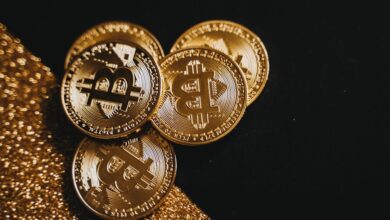Navigating Gold Futures and Options: A Comprehensive Guide to Speculating on Gold Prices Through Derivatives

In recent years, the allure of gold has captivated investors, traders, and collectors alike, as they seek to navigate the complex landscape of gold investment. As a safe haven asset, gold has consistently demonstrated its resilience amid economic fluctuations, making it an attractive option for those looking to diversify their portfolios. This article delves into the fascinating world of gold futures and options, exploring how derivatives can be used to speculate on gold prices and capitalize on market trends. We will provide a comprehensive guide to understanding gold futures and options, analyze the factors that influence gold market trends, and examine the role of gold as a protective asset in times of inflation and global uncertainty. Whether you're interested in investing in gold ETFs, gold coins, or physical gold, this article will equip you with the knowledge needed to make informed decisions in the ever-evolving gold trade landscape. Join us as we explore the intricate dynamics of gold investment, the impact of central banks' gold reserves, and the future of sustainable gold mining practices.
- 1. Understanding Gold Futures and Options: A Comprehensive Guide to Derivatives in Gold Investment
- 2. Analyzing Gold Market Trends: How Gold Prices React to Economic Factors and Investor Sentiment
- 3. The Role of Gold as a Safe Haven Asset: Exploring Its Value Amid Inflation and Global Economic Uncertainty
1. Understanding Gold Futures and Options: A Comprehensive Guide to Derivatives in Gold Investment
Investing in gold through derivatives like futures and options has become increasingly popular among traders and investors looking to capitalize on fluctuations in gold prices. Understanding these financial instruments is crucial for anyone interested in gold investment, whether through physical gold, gold ETFs, or gold mining stocks.
Gold futures are contracts that obligate the buyer to purchase, or the seller to sell, a specified amount of gold at a predetermined price on a set future date. This allows investors to speculate on the direction of gold market trends without having to own physical gold. For instance, if an investor anticipates rising gold prices due to factors like inflation or increased global demand, they may buy gold futures to lock in lower prices.
On the other hand, gold options give investors the right, but not the obligation, to buy or sell gold at a specified price before a certain date. This flexibility can be particularly beneficial in volatile markets, allowing traders to hedge against potential losses or to leverage their positions with less capital than investing in physical gold outright.
Both gold futures and options are influenced by various factors, including central banks' gold reserves, changes in gold production, and developments in the sustainable gold mining sector. As countries continue to stockpile gold as a safe haven asset, the dynamics of the gold trade can shift significantly. Moreover, innovations in gold technology and recycling methods have also altered how gold is sourced and valued in the market.
Traders often analyze gold market analysis reports to gauge current trends and make informed decisions. These analyses may include insights on luxury gold products, such as gold jewelry and collectibles, as well as the impact of gold smuggling and illegal trade on global gold demand.
Additionally, the relationship between gold and cryptocurrency has emerged as a topic of interest, with many investors viewing gold coins as a hedge against the volatility of digital currencies. This intersection of traditional and modern investment strategies highlights the versatility of gold as an investment vehicle.
In summary, understanding gold futures and options provides investors with powerful tools to navigate the complexities of the gold market. By leveraging these derivatives, one can speculate on price movements, hedge against market fluctuations, and ultimately enhance their gold investment portfolio.
2. Analyzing Gold Market Trends: How Gold Prices React to Economic Factors and Investor Sentiment
The gold market is influenced by a myriad of economic factors and investor sentiment, making it essential for traders and investors to analyze these trends carefully. Gold prices often react to changes in global economic conditions, inflation rates, and geopolitical events. As a safe haven asset, gold is sought after during times of economic uncertainty, leading to increased demand and rising prices. When inflation rates surge, for instance, many investors turn to gold investment, viewing it as a hedge against inflation. Historically, gold has maintained its value better than other assets during inflationary periods, which can drive up gold market trends.
Investor sentiment also plays a crucial role in shaping gold prices. Positive sentiment towards gold can lead to increased buying activity, particularly in gold ETFs, which allow for easy access to gold without the need for physical gold ownership. Conversely, negative sentiment, often driven by confidence in other investments such as stocks or cryptocurrency, can cause a decline in gold prices. The interplay between gold and cryptocurrency is particularly noteworthy as digital currencies gain popularity among younger investors, who may opt for these new alternatives over traditional gold investments.
In addition to economic indicators and investor psychology, external factors such as central banks' gold reserves and the overall gold trade landscape impact market dynamics. Central banks hold gold to diversify their reserves and stabilize their currencies, which can influence global gold demand. Furthermore, developments in sustainable gold mining practices and gold recycling initiatives are increasingly shaping consumer attitudes towards gold products, including gold jewelry and gold coins.
For those interested in gold collectibles and bullion, understanding market analysis is crucial, as price fluctuations can be influenced by gold production rates and the refining process. Trends in gold mining output and technological advancements in gold extraction can affect supply levels, further impacting gold prices. As the global gold demand evolves, so too will the strategies for speculating on gold futures and options, ensuring that investors remain informed about the complexities of the gold market.
3. The Role of Gold as a Safe Haven Asset: Exploring Its Value Amid Inflation and Global Economic Uncertainty
Gold has long been revered as a safe haven asset, especially during times of economic uncertainty and rising inflation. As investors seek stability, gold often becomes a focal point for gold investment strategies. Historically, gold prices tend to remain resilient when inflation rates climb, as people turn to gold as a hedge against diminishing purchasing power. This relationship between gold and inflation makes gold futures an attractive option for speculators looking to capitalize on anticipated price movements.
In the current global economic landscape, marked by geopolitical tensions and fluctuating market conditions, the allure of gold continues to grow. Central banks are increasing their gold reserves, reflecting a strategic move to bolster their financial stability amid uncertainty. This trend underscores the importance of gold market analysis, as fluctuations in demand from central banks can significantly influence gold prices.
Moreover, the rise of gold exchange-traded funds (ETFs) has democratized access to gold investment, allowing a broader range of investors to participate in the gold market without the need for physical gold storage. Gold ETFs track the price of gold bullion and provide a convenient way to gain exposure to gold market trends.
The luxury gold sector, including gold jewelry and collectibles, also plays a vital role in global gold demand. As emerging markets grow, the appetite for gold jewelry and luxury items continues to rise, further supporting gold prices. Additionally, sustainable gold mining practices are gaining traction, appealing to environmentally-conscious investors who prioritize responsible sourcing.
Despite the challenges posed by gold smuggling and illegal trade, the fundamental value of gold remains intact. Gold recycling and refining processes contribute to the sustainability of the gold market, ensuring a continuous supply of this precious metal.
In conclusion, the unique characteristics of gold as a safe haven asset, coupled with ongoing global economic challenges, position it as a vital component of modern investment strategies. Whether through gold futures, physical gold, or gold coins investing, understanding the dynamics of the gold market is essential for navigating today’s economic landscape.
In conclusion, speculating on gold prices through futures and options offers investors a unique opportunity to navigate the complexities of the gold market. Understanding the nuances of these derivatives is crucial for making informed decisions in the realm of gold investment. As we explored, gold market trends are heavily influenced by economic factors and investor sentiment, which makes it essential to stay updated on market analysis and trends.
Moreover, gold's status as a safe haven asset becomes increasingly relevant amid inflation and global economic uncertainty. With gold reserves held by central banks and the rise of gold ETFs, investors have various avenues to diversify their portfolios. The ongoing global demand for gold, encompassing everything from jewelry and collectibles to technology, ensures that gold remains a pivotal fixture in the financial landscape.
As you consider engaging in gold futures and options, remember to assess the risks and benefits associated with this form of investment. Whether you are looking to invest in physical gold, gold bullion, or explore sustainable gold mining practices, knowledge is your most valuable asset. By staying informed about gold prices, refining processes, and the broader gold trade, you can make strategic moves that align with both your financial goals and ethical considerations in today’s dynamic market.





